By Will Grunewald, Brian Kevin, and Adrienne Perron
From our March 2022 issue
Every few years, Down East takes a close look at what makes a great place to live in Maine, and this year, we asked readers to weigh in. Our editors seeded a March Madness-style bracket tournament with 16 towns from all across the state, each offering a little something different. We followed a few ground rules: For starters, we didn’t include any towns that appeared in our last Best Places feature, in 2020. We took into consideration Maine’s gonzo real-estate market. And we gave points to towns we love for their quality of life — easy access to the Maine outdoors, lively or up-and-coming Main Streets, proximity to interesting dining and retail.
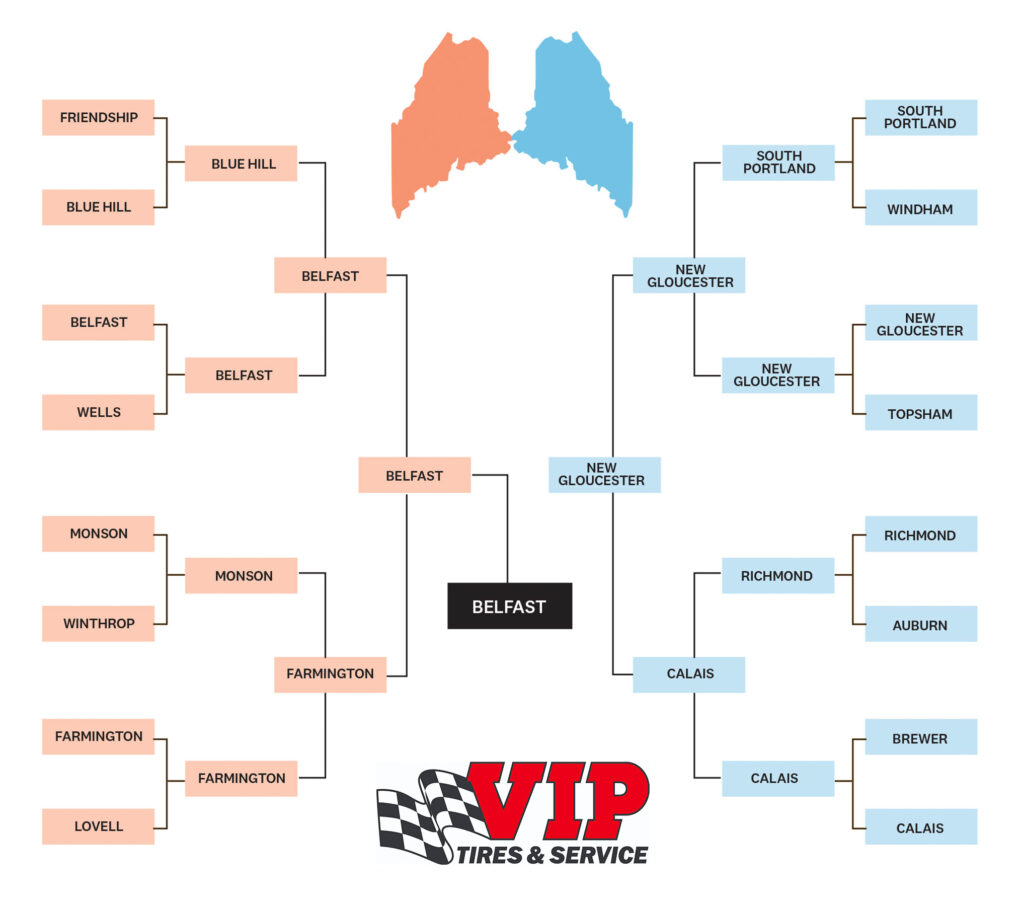
Then, thousands of readers took over, voting in four elimination rounds to select one best-in-show Maine hometown. The winners run the gamut, from the state’s fourth-largest city to its third smallest, from mountain enclaves to seaside centers.
The Winner: Belfast
At the heart of the midcoast and offering the best of many worlds, our readers’ favorite town.
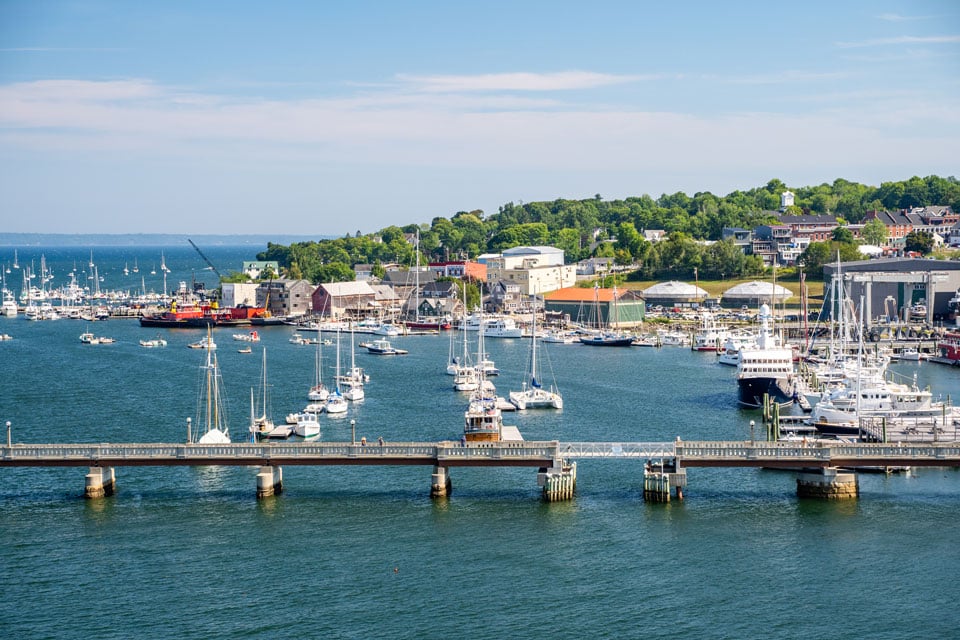
Belfast is a town that’s worn every collar and somehow ended up with the best characteristics of each one. The town’s blue-collar backbone owes to more than two centuries of shipbuilding and maritime trades, carried on today at Front Street Shipyard, along with the poultry plants that made the town the “Chicken Capital of America” in the middle 20th century. The white-collar boom came between 1995 and 2005, when credit-card titan MBNA invested heavily around town and paved the way for Athenahealth and Bank of America, now among the midcoast’s largest employers. Belfast gets its green collar in part from waves of boomer hippies and homesteaders who washed over the area when land was cheap in the ’60s and the ’70s. Their influence is felt around town in everything from the middle school’s nationally recognized garden-and-greenhouse program to the acclaimed farm-to-table café Chase’s Daily to the Belfast Cohousing & Ecovillage to the headquarters of the Maine Farmland Trust.
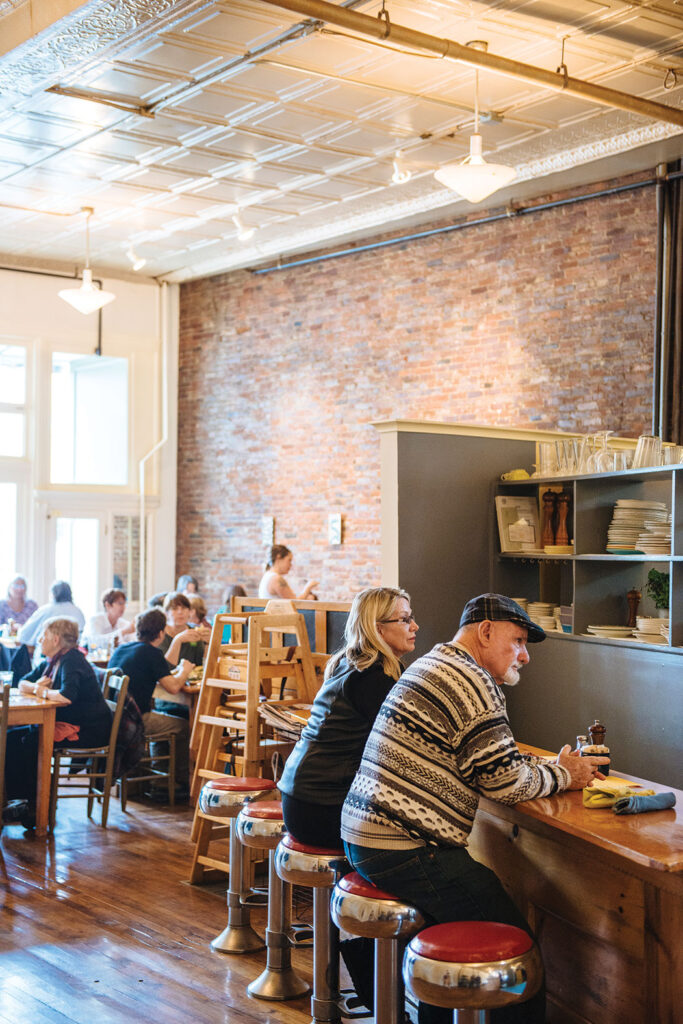


Pre-pandemic diners at Chase’s Daily, a vegetarian bakery and café (and farmers market); the art-deco facade of the Colonial Theatre; rowing on Belfast Bay. Photos by Mark Fleming and Benjamin Williamson.
As in towns across Maine, Belfast has seen real-estate prices spiral of late, although unfortunately, the city isn’t an outlier in the region — there aren’t many Waldo County towns where median home price hasn’t well outpaced median income. The livability website Niche recently crowned Belfast as Maine’s best town to retire in — very walkable, great health-care infrastructure, a robust senior college at UMaine’s Hutchinson Center — which might help explain a median age two years higher than the state’s. Belfast is one of the more diverse towns on the not-particularly-diverse midcoast, with people of color comprising some seven percent of Belfastians, though that’s still less than the statewide percentage of nearly nine.
Main Street, which seems never to have an empty storefront, overlooks the Passagassawakeag River, which wends alongside a popular rail trail and a few lovely nature preserves. Nicolle Littrell moved to Belfast 20 years ago and runs DoryWoman Rowing, leading guided rows and tours on the river and Belfast Bay in a traditional wooden dory (even in winter). The water, she says, is integral to the city’s character. “It’s just like an artery running through town,” she says. “Upriver was once the seat of industry. You look at the structures built on it, the footbridge connecting both sides. The river and the bay are really just the full heart of Belfast.” — B.K.
| Population | 6,938 |
| Median Age | 47 |
| Median Household Income | $64,784 |
| Income Needed to Afford Median Home | $94,742 |
| # of Homes Sold Last Year | 108 |
The Runner-Up: New Gloucester
An ideally located farm town offering plenty more than fields and barns.

Krista Kern Desjarlais was living in Portland, where she was chef-owner of an upscale restaurant, when she and a date took a drive up to New Gloucester to pick apples at Thompson’s Orchard. “As we got up the ridge, there’s this beautiful view, and I was like, ‘Wow, this is totally the kind of place I would love to live,” she recalls. Her date that day was a fellow Portland chef and, it turned out, her future husband, Erik. After they had married and had a kid, they moved out of the city and into an old house in New Gloucester’s village center. Every year, they still go back to Thompson’s Orchard, for apples, hay rides, cider doughnuts, and Christmas trees, depending on the season.
The couple has lived in New Gloucester for a decade, just around the corner from the public library and New Gloucester Village Store, where Erik makes the pizzas. In the summer, Krista, a multiple-time nominee for the James Beard Award for best chef in the Northeast, manages the swimming hole and boat landing at Outlet Beach, on Sabbathday Lake, and runs its snack shack, Bresca & the Honeybee, serving up her own line of ice cream, in flavors ranging from salted olive oil to Maine blueberry to tiramisu. On a busy day, the beach might see a few hundred visitors. “I’m basically a park ranger during the day — ‘No smoking!’ ‘Don’t jump off this!’ ‘Don’t break that!’” Over the years there, she’s gotten to know countless kids and parents as well as a fair few older residents who just like to come and sit by the water with a cone.
Though it’s an easy commute to Portland, Brunswick, or Lewiston–Auburn, New Gloucester is rural and rolling, with lots of agricultural and recreational space. In addition to the lake, there’s Pineland Farms, a 5,000-acre working farm plus a trail center for cross-country skiing, snowshoeing, fat-tire biking, sledding, and skating in winter and disc golf, walking, and mountain biking in summer. The Royal River Conservation Trust manages an extensive network of preserves, and the eponymous river is popular with paddlers. And just down the road from Desjarlais’s beach outpost is the Sabbathday Lake Shaker Village, the world’s last active community of Shakers, where a museum and shop, plus public workshops on everything from needle felting to pie baking to basket weaving, draw visitors in.
In a sense, the Shaker way isn’t so different from the broader New Gloucester way. “There’s community here, but you could also have a very peaceful, solitary life,” Desjarlais says. “I like that it’s both of those things: community is available whenever you want it, but it’s also nice and quiet.” — W.G.
| Population | 5,676 |
| Median Age | 40 |
| Median Household Income | $85,564 |
| Income Needed to Afford Median Home | $90,371 |
| # of Homes Sold Last Year | 75 |

This year’s Best Places to Live Tournament was sponsored by VIP Tires & Service, found in 33 communities all across Maine.
Blue Hill
Breezy and bohemian, with a landscape that couldn’t be more Maine.

A few years back, a gushy New York Times piece about writers summering in Blue Hill declared the seaside Hancock County hamlet a place where “well-heeled New York holidaymakers, organic farmers, and lobstermen coexist in rustic harmony.” That might be overselling it, but Blue Hill’s reputation has long been of a melting pot of artsy types and free spirits. In the early 20th century, enough cultured rusticators gathered to found Kneisel Hall, still a world-class chamber-music school. Many decades on, waves of back-to-the-landers left their mark, not least by founding the Blue Hill Co-op, Maine’s largest cooperative grocery since it expanded in 2019 (and among the country’s finest). And yes, NYT, the town and surrounding peninsula — all blueberry barrens, spruce woods, and rocky shores — are plenty rustic.
“If you don’t like malls, shopping, or infrastructure, this is a great place to be,” says Blue Hill native Charlotte Clews, a child of two of those back-to-the-landers and a product of the Bay School, the town’s 42-year-old Waldorf elementary. “A traffic jam here is still a rare occurrence.”
A Registered Maine Guide who now leads wilderness trips for Maine youth (including, often, her own kids), Clews ran a yoga and Pilates studio until early in the pandemic, and she’s a former staffer at the Blue Hill Heritage Trust, which stewards more than 31 miles of trails within a short drive of the harborfront commercial center. Like plenty of others, she’s noticed the town is in the midst of another wave of newcomers (“the number of nice new cars around lately is remarkable”), and while that’s certainly driving up home prices, Clews says the homesteader ethic isn’t yet in retreat. “You can still get by here on a little, and lots of us keep low overhead, heat with wood, drive beaters — that’s still a viable approach,” she says. “There’s no keeping up with the neighbors here, and I hope it stays that way.” — B.K.
| Population | 2,792 |
| Median Age | 50 |
| Median Household Income | $64,343 |
| Income Needed to Afford Median Home | $91,351 |
| # of Homes Sold Last Year | 59 |
Farmington
A college town with all the perks — and plenty of outdoor splendor.
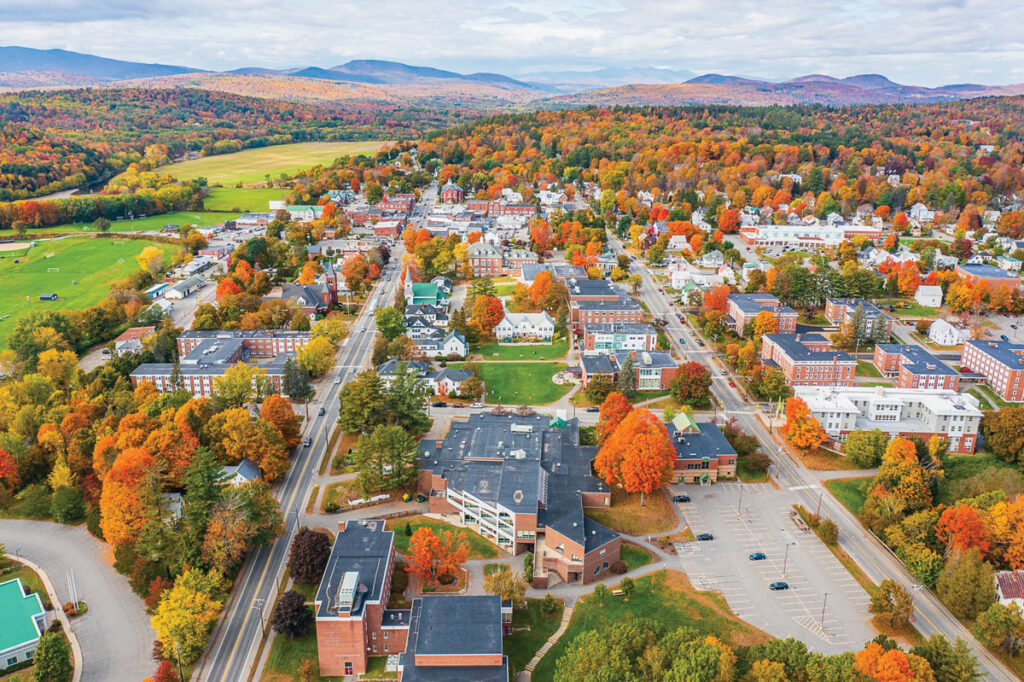
Something about Farmington seems to lure and nurture creative minds. For University of Maine Farmington professor Amy Neswald, who moved to town four years ago, selling points include the profound beauty of the surrounding woods and mountains and a growing number of arts-related businesses and organizations, like Vera’s Iron and Vine, which sells artisan Maine-made goods, and the Belle Creative Arts Center, in neighboring Wilton, which offers workshop space and arts classes and events.
The presence of a state liberal-arts university certainly gets a lot of credit for Farmington’s creative culture. Neswald, a novelist and filmmaker, came to teach creative writing, leaving a New York City career as a wig master on Broadway. Now, she runs the university’s Visiting Writers Series, one of many UMF programs and events that attract non-student locals. Downtown businesses benefit from the adjacent campus too. There’s no other western Maine downtown where shoppers can choose from a handful of coffee shops and two top-notch bookstores, frequent multiple date-night restaurants and boutiques, catch a movie on the big screen, put together a respectable pub crawl, and pick up both their full grocery list and their splurgy gourmet specialties.
Not that you’d call Farmington cosmopolitan, exactly, and plenty of locals are less excited about lit readings than lift tickets — at the town’s small but varied Titcomb Mountain, say, or at Sugarloaf, just 45 minutes away. Hiking, biking, and skiing trails abound, like the nine-mile network at the 188-acre Powder House Hill preserve, just blocks from downtown, and Neswald’s as surprised as anyone to find herself thrilled by the proximity. “I never saw myself living outside an urban center,” she says, “but there is something so rich about being able to go out near where I live and go for a walk in delicious, rich quiet.” — A.P.
| Population | 7,592 |
| Median Age | 39 |
| Median Household Income | $44,129 |
| Income Needed to Afford Median Home | $66,583 |
| # of Homes Sold Last Year | 84 |
Monson
At the edge of Maine’s north woods, a quintessential trail town on the upswing.

John Wentworth grew up in Monson, spent a few years in New Orleans as an adult, then found himself back in his hometown to raise his family. Lately, he feels like a trend-setter. “There’s a renewed interest in small-town Maine life again,” the 70-year-old woodworker observes.
It wasn’t always this way. A decade ago, Monson was reeling from the closure of its elementary school and its largest employer, furniture maker Moosehead Manufacturing Company, owned in part by Wentworth’s family. More recently, Maine’s nonprofit Libra Foundation has sunk $10 million into infrastructure improvements around the north woods town it called “a great place to do investment.” Libra capital has since catalyzed fiber-optic broadband downtown, a new health clinic, a general store, a fine-dining restaurant, and an arts residency modeled on Deer Isle’s Haystack Mountain School of Crafts.
The town’s natural attractions, of course, needed no facelift. The Appalachian Trail passes right through — Monson is a north-bound hiker’s last stop before the famed 100-Mile Wilderness, and a Monsonite can leave work and be at the Borestone Mountain trailhead in 20 minutes. A new AT visitor center opened downtown five years ago, and the Adirondack chairs overlook Lake Hebron, at the center of town. Monson is big with paddlers and anglers in summer and ice fishermen in winter, when the Narrow Gauge Riders Snowmobile Club grooms 31 miles of trails that access the state’s vast Interconnected Trail System.
The town’s 2022 bicentennial is a chance for Monsonites to reflect on the town’s history — first, as a slate-mining center, then, as a hub of craftspeople at the furniture plant — and to envision what Wentworth calls the “next big thing.” For Wentworth, who’s served breakfast to AT hikers at Shaw’s Hiker Hostel and helped organize the town’s Summer Fest and Snow Roller Day, the constant is the sense of community.
“People might think Monson is another small town with not much to offer,” Wentworth says. “But for a town of 600, what we have is extraordinary.” — A.P.
| Population | 609 |
| Median Age | 57 |
| Median Household Income | $45,962 |
| Income Needed to Afford Median Home | $49,870 |
| # of Homes Sold Last Year | 12 |
South Portland
One of Maine’s most competitive real-estate markets — and not just because of the town next door.

Not long ago, South Portland’s biggest selling point was proximity to Portland, but the sidekick city has come a long way. Joe Cassidy lived in the area in the early aughts, moved elsewhere around the state, then settled in South Portland in 2018, to take over as president of Southern Maine Community College. “Coming back and seeing how invigorated the city had become was really fun,” Cassidy says. “It’s an eclectic place — families who have roots that go back generations, plus lots of young families and retirees who have come in, as well as new Mainers who immigrated here.”
Cassidy understands what makes a community tick — he once served as mayor of his hometown, Calais, as did his father and grandfather before him — and the college plays a big part. The campus is the site of historic Fort Preble, scenic Spring Point Ledge Light, and a section of the city’s Greenbelt Walkway, on which Cassidy and his wife and teenage son like to bike. It’s also adjacent to Willard Beach, a lovely crescent of sand where residents while away summer days. “As a college,” Cassidy says, “we’re lucky to be so central to the overall sense of community here. It’s pretty unusual.”
In the winter, Cassidy and his son ice fish on the ponds at Hinckley Park, near the revitalized Knightville neighborhood, where a bevy of restaurants, cafés, breweries, and shops has popped up. The small city is also home to several notable performing-arts groups, including the Portland Players and Mad Horse Theatre Company, not to mention some major employers, like Wex and Texas Instruments. “South Portland has its own identity now,” Cassidy says. “It’s nice to be associated with big brother across the bay there, but so much has grown up here in the past 20 years.” — W.G.
| Population | 26,498 |
| Median Age | 42 |
| Median Household Income | $76,408 |
| Income Needed to Afford Median Home | $107,630 |
| # of Homes Sold Last Year | 296 |

This year’s Best Places to Live Tournament was sponsored by VIP Tires & Service, found in 33 communities all across Maine.
Calais
Way Down East, a Rockwellian burg — and a bargain.
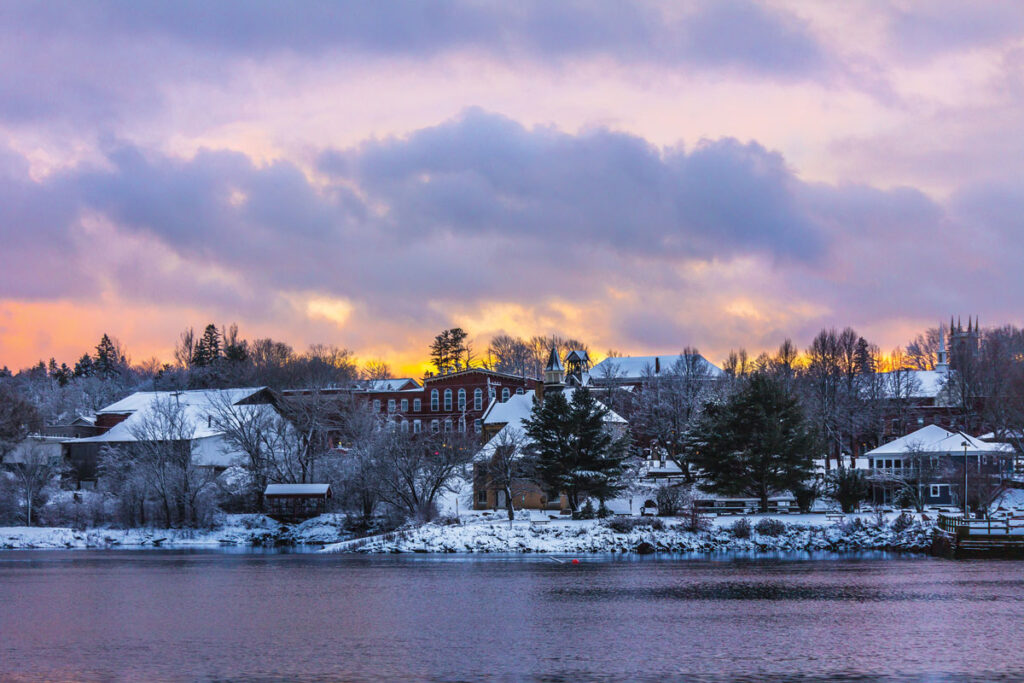
Three bedrooms, two baths, in 2,500 freshly updated square feet, 500 yards from tidal waterfront, with a porch, a yard, and an attached two-car garage. Along much of Maine’s coast, that’s a million-dollar home. In Calais, it listed for just over $220,000 last summer.
The folks who moved in? They’ve got 20,000 acres of Moosehorn National Wildlife Refuge in their dooryard, miles of coastline to explore along Passamaquoddy Bay, and some of the state’s best paddling and fishing 30 miles away, in Grand Lake Stream. If they work remotely, they’re in luck — this year, every Calais household gets access to fiber-optic internet, thanks to the state’s first city-owned broadband network.
Yes, that’s “city-owned.” Calais is Maine’s third-smallest city, although the feel is undeniably small-town, says humorist Tim Sample, who, with his wife, had a house in the heart of Calais until a few months ago and still owns a camp outside town. “Maybe it’s my rose-colored glasses,” he says, “but it has this Jimmy Stewart, Norman Rockwell atmosphere. It reminds me of Boothbay Harbor in 1961, before it was a destination. At the gas station, the post office, the hardware store, there’s just this sort of pleasantness. And a lot of community pride — we joke that every week in the Calais Advertiser there’s somebody holding up one of those giant checks after a fundraiser.”
And it only looks remote on a Maine map, Sample reminds: just across the river are 10,000 New Brunswickers, between the towns of St. Stephen and the busy (in summer) resort town of St. Andrews-by-the-Sea. “People say, oh, you’re at the end of the Airline, you’re in the middle of nowhere!” Sample says. “And I say, oh, well, there’s a Michelin-quality restaurant 25 minutes away.” — B.K.
| Population | 3,079 |
| Median Age | 45 |
| Median Household Income | $34,393 |
| Income Needed to Afford Median Home | $37,277 |
| # of Homes Sold Last Year | 48 |
Richmond
A tucked-away river town that’s in the middle of it all.


Striking facades around Richmond, including a gem of a small-town pub. Photos by Greta Rybus.
At $250,000, the median home price in rural, riverside Richmond is the lowest in the Brunswick micropolitan area — which includes Harpswell, Topsham, and basically any town that touches the Kennebec south of Gardiner. Richmond, as it happens, is the northernmost of these, a 20-minute commute to either Augusta or Brunswick. And while the heart of Richmond is on the river, not the interstate, it’s a half-hour drive to Portland or Lewiston from the town’s lone exit on I-295.
“It’s a cool place like that, because when you’re there, you do feel like you’re tucked away, like you have your own space,” says Cara Taggersell, an associate broker for Urban and Rural Real Estate, “but it’s really in the middle of everything, really on the map that way.”
From U&R’s nascent Richmond office — an 1890 Victorian undergoing a restoration by the agency’s owner, Mandy Wheeler, and a fleet of helpers and contractors — it’s a five-minute walk to Annabella’s Bakery & Cafe, where Taggersell likes to grab breakfast burritos. The patio tables out front overlook the Kennebec River and Swan Island, a state recreation site accessed by private boat and public ferry, full of hiking and biking trails and abandoned 19th-century farmsteads. Across the street, the Old Goat is a community hub that’s anchored Richmond’s downtown since 2004, a classic New England pub in an 1872 bank building.
In Richmond, as in most of Maine, the biggest impediment to buying right now is low inventory, but Taggersell says she sees lots being built upon and expects the market to loosen as the year goes on. “I do think Richmond is a viable option,” she says. “You can still find a nice single-family home for under $300,000, and it’s a little gem of a place.” — B.K.
| Population | 3,522 |
| Median Age | 46 |
| Median Household Income | $58,912 |
| Income Needed to Afford Median Home | $69,778 |
| # of Homes Sold Last Year | 44 |
Note: Population and age come from the most recent U.S. Census Bureau data. Median household income, income needed to afford a median home, and number of homes sold come from MaineHousing’s 2021 Homeownership Affordability Index. These stats provide only a generalized snapshot of a community and a starting point for further research.


